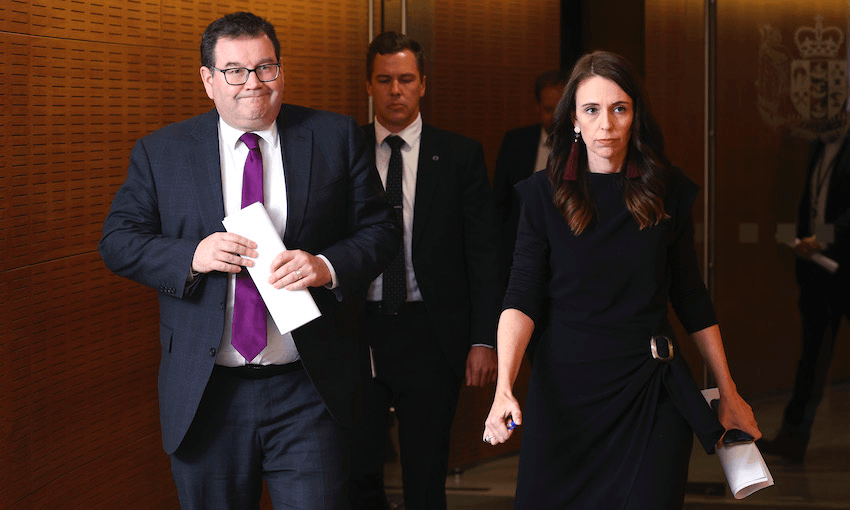The government is blaming misreporting for anger over a pay freeze for the public sector. Justin Giovannetti looks at the prime minister and finance minister’s claim that public servants are being misled by the media.
Last Wednesday the government issued guidance which became immediately and almost unanimously characterised as a “pay freeze” for most of the public sector earning over $60,000 a year. Yesterday, finance minister Grant Robertson declared there had been a misunderstanding. These were “income adjustments” he said. “It is important to note that this is not as has been reported, a pay freeze.”
A few hours later, the prime minister also blamed any anger at a freeze on incorrect reporting.
Are they right? Has it been misreported?
The Spinoff rewound the clock to May 5 2021 when the Public Service Pay Guidance was announced by the minister for the public service, Chris Hipkins.
Hipkins, speaking during an early morning press conference that day, did not use the word “freeze”. He did, however, call on the public sector to step forward and lead the government’s efforts towards “moderation and restraint” in the pursuit of “fiscal responsibility” through their pay packets.
“Any pay increase over the next three years will be targeted to low-income public servants, that’s those earning less than $60,000 per year,” said Hipkins. About a quarter of the public service makes less than $60,000.
There would be “no pay increase for those earning over $100,000 and senior leaders within the public service”, he continued, as Robertson stood alongside him.
“For those in between, pay adjustments will be considered in special circumstances, but they will need to work through the Public Service Commission. This is ultimately about prioritising spending. The policy will help us protect jobs and take pressure off the public sector wage bill,” Hipkins concluded.
That last point from the minister, uttered in the same breath as his guidance for most public workers, made it clear that the intent is to reduce spending on wages by only allowing adjustments in special circumstances.
Reporting across the major news organisations that day said the government was freezing pay for most of the public sector and pointed out that people earning under $60,000 would be exempt from that freeze. Stories also allowed that some workers making less than $100,000 might get increases under special circumstances.
After criticism, anger and petitions over the story, it’s no wonder the government would like to see different language used.
Speaking during her media rounds yesterday, prime minister Jacinda Ardern led the messaging shift. Some public sector employees will still see increased incomes because of movements within their pay bands or because of cost-of-living increases from collective agreements, she said.
There’s been no suggestion, in the mainstream media or elsewhere, that the government has torn up existing collective agreements to remove cost of living increases or other planned pay changes.
An hour later in a pre-budget speech in Auckland, Robertson suggested misreporting was to blame for anger over the freeze.
“It is important to note that this is not as has been reported, a pay freeze,” he said. “Pay for public servants such as teachers, nurses and police officers will continue to increase as they move through the pay bands we have previously agreed, pay equity discussions continue and there is still a collective bargaining negotiation to go through.”
Robertson then tried to clarify the public sector guidance Hipkins released last week.
“This guidance has a focus on the 25% of public sector employees who are on $60,000 a year or less,” Robertson said. “The guidance breaks down three categories for public sector pay: ‘lift’ those at $60,000 or below, ‘adjust’ those between $60,000 and $100,000 and ‘hold’ those above $100,000,” he said.
On Monday evening, hours after Robertson spoke, Ardern reiterated her finance minister’s position that reporting was to blame for anger in the public sector.
“When I read some of, perhaps what they are reacting to, if they are left with the impression that for instance that we aren’t going to follow through with existing agreements, that we aren’t going to allow pay progression, then perhaps that impression isn’t surprising and isn’t wrong,” she said.
The government spent much of yesterday repeating the exceptions and special circumstances that let people get around the guidance. As part of that, they began to use new language. Robertson’s lift/adjust/hold terminology was not used by the ministers in their media conference last week.
It does appear, however, in the Public Service Commission guidance (which you can read here). Importantly, however, the “adjusting” category (for those between $60,000 and $100,000) is defined as follows: “The default position is that there are to be no increases to bands for lower to middle earners.”
That sounds a lot like a freeze. To suggest that the use of such a word constitutes misreporting is dancing on the head of a pin.





